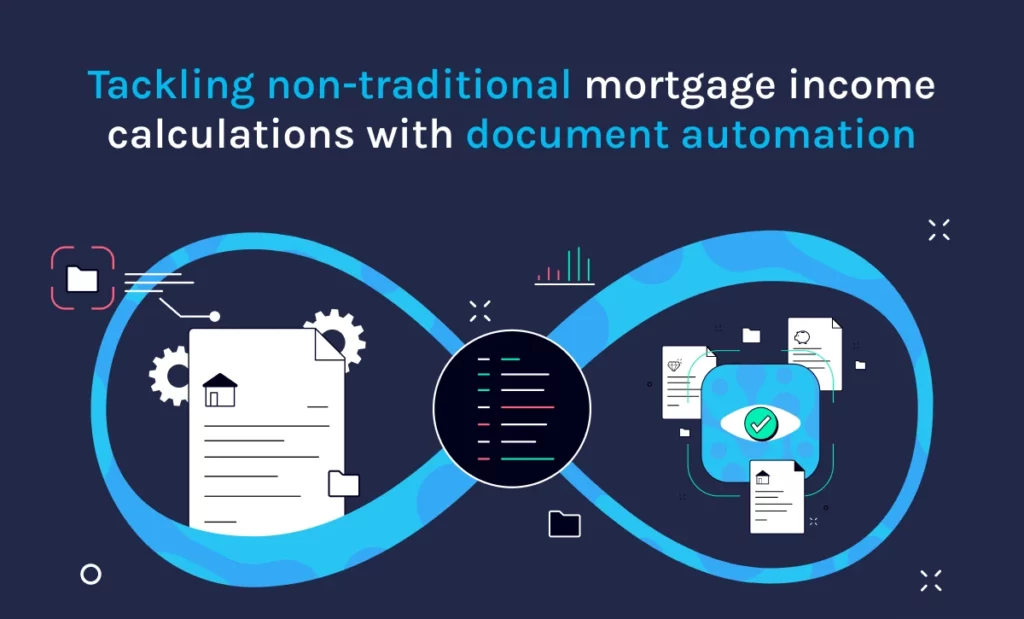This website uses cookies so that we can provide you with the best user experience possible. Cookie information is stored in your browser and performs functions such as recognising you when you return to our website and helping our team to understand which sections of the website you find most interesting and useful.
Tackling non-traditional mortgage income calculations with document automation

In the rapidly evolving mortgage landscape, lenders are confronted with the tricky task of making income calculations for a wide range of borrower types.
Calculating precise incomes can pose substantial challenges, especially when dealing with self-employed individuals or those with non-traditional income sources. This precision is critical for granting accurate approvals and making informed decisions that minimize potential risks.
When integrated into the lending process, document automation can significantly improve the speed and accuracy of income calculations – even for non-traditional borrowers – enabling lenders to approve more loans more quickly – and with greater confidence.
Challenges in income calculation for mortgage lenders
Calculating and analyzing the income of non-traditional borrowers poses unique challenges for mortgage lenders. Whether they’re freelancers, contractors, self-employed or have multiple income sources, these borrower profiles introduce additional complexities into the income calculation process.
Moreover, the manual process of income calculation is not just time-consuming but can be prone to human error. Inconsistencies in documentation can further complicate the process. These factors can lead to an inaccurate understanding of a borrower’s financial stability, potentially resulting in misguided lending decisions.
In the face of these challenges, there is a growing need for more accurate, efficient and comprehensive processes to assess and streamline borrower income calculations for all types of borrowers while minimizing risk for lenders.
The role of document automation in mortgage lending
By automating the classification, capture and analysis of financial documents, document automation technology significantly reduces the time and effort required to accurately calculate a borrower’s income. These tools extract data from various document types and formats, converting it into usable data while cross-referencing information to ensure consistency and reliability.
For mortgage lenders, document automation helps streamline the review and processing of complex financial documents, which is invaluable when dealing with non-traditional or gig worker income verification. By reducing the reliance on manual review, lenders can obtain a more complete and reliable view of a borrower’s financial situation, even when that picture is complicated by multiple income streams, helping level the playing field in mortgage lending.
Ocrolus’ mortgage dashboard helps streamline borrower income calculations for non-traditionally employed applicants and applications with multiple borrowers or employers. Lenders can consider various income calculations from the most conservative to the least, providing an objective and standardized approach to evaluating each borrower’s income based on their unique circumstances.
Case study: Automating the automatable
Compeer Financial, a cooperative based in the Midwest, provides a variety of financial solutions, including home mortgages and diverse consumer loans. Despite their commitment to efficient service, Compeer encountered significant hurdles with document processing within their Rural Living Solutions (RLS) unit.
Handling an annual loan volume of $2 billion with a team of only 100, the RLS unit needed to optimize their operations – which meant redirecting their staff’s focus from the repetitive tasks of document verification to more valuable work such as nurturing customer relationships.
Ocrolus helped the RLS unit achieve its goals by “automating the automatable.”
For example, RLS operations staff leveraged Ocrolus’ human-in-the-loop document automation platform to transpose all necessary data into the loan origination system (Encompass by ICE Mortgage), run calculations on the data to determine borrower’s creditworthiness1 and verify income.
As a result of automating these tasks, Compeer’s RLS unit reported more efficient operations. Using Ocrolus, RLS staff cut the time it takes to process complex files with multiple entities in half and the time it takes for standard files by 20-25%.

Managing income calculations in today’s changing mortgage market poses growing challenges for lenders – especially when it comes to non-traditional borrowers. As financial landscapes evolve and become more complex, mortgage lenders are increasingly looking for more efficient, accurate and reliable ways to assess and analyze applicant income.
Adopting document automation technology helps mortgage lenders make data-based decisions and streamline the intricate task of income verification for diverse applicant profiles. As the market continues to diversify, embracing these technological aids becomes not just beneficial, but essential for lenders aiming to stay relevant and competitive in the mortgage industry.
By reducing the manual workload, improving data accuracy and speeding up the decision-making process, document automation plays a critical role in modern mortgage lending practices. These tools not only enable mortgage lenders to accommodate a broader range of applicant financial scenarios with consistency and reliability, they also foster a more efficient, customer-friendly process that enhances the overall loan origination process.
Book a demo to learn how Ocrolus can help mortgage lenders streamline income calculation for borrowers with non-traditional income through AI-driven document automation.
Key takeaways
- Document automation technology streamlines income calculations for non-traditional mortgage borrowers, such as freelancers and self-employed individuals, reducing manual effort and minimizing errors.
- Compeer Financial, a Midwest cooperative, successfully improved efficiency by automating document processing and income verification tasks using Ocrolus’ document AI platform, ultimately reducing loan processing time.
- Embracing document automation is essential for mortgage lenders to stay competitive and relevant in a changing market, enabling them to make data-based decisions and enhance the loan origination process.





